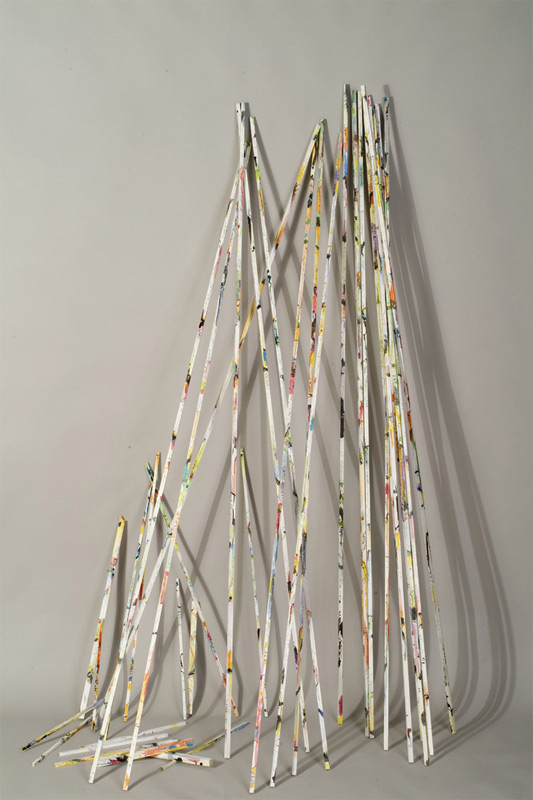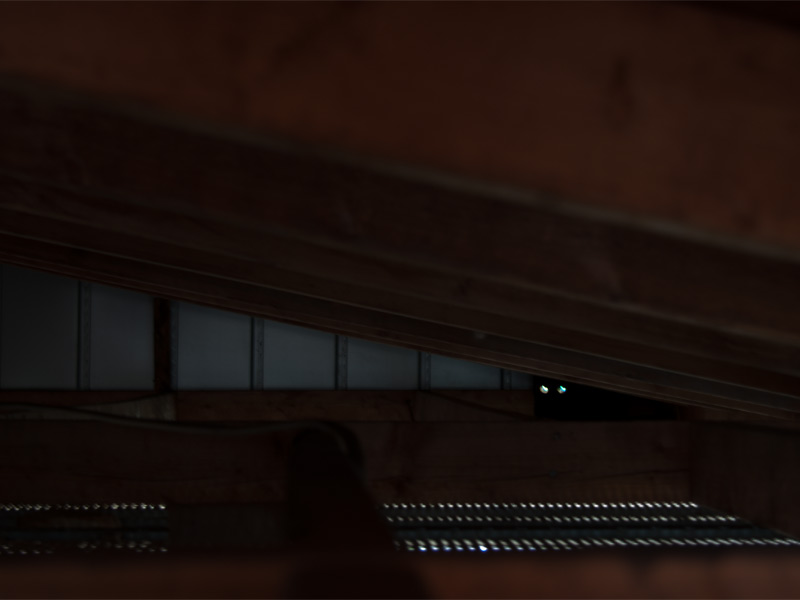Postmodern art

[Anna Jóelsdóttir. 25 bâtons, 2007. Peinture acrylique et encre sur bois, 213 x 5 x 5 cm. Galerie Stux.]
[…] Quatrième dogme majeur : la toute-puissance du commissaire d’exposition. L’art contemporain offre à celui-ci une chance exceptionnelle : celle de voir ses idées prévaloir sur l’identité de l’artiste, sur l’œuvre, et par conséquent sur l’art lui-même. L’équation est parfaite: les commissaires étant des incontinents rhétoriques, ils éprouvent un besoin viscéral de produire les textes les plus invraisemblables. La pierre angulaire de cette opération étant que l’œuvre d’art contemporain le permet en n’étant pour ainsi dire rien ; on peut donc en dire ce qu’on veut et tout texte, aussi démesuré soit-il, s’impose à elle.
Quels que soient l’imagination et le bagage intellectuel qu’on y investisse, écrire des textes spéculatifs et rhétoriques sur des dessins d’Egon Schiele rencontre une limite. L’œuvre a déjà tout dit, elle est imposante et aucun mot ne pourra jamais l’égaler. Le critique ou l’expert s’expriment à leurs risques et périls, car l’œuvre est toute-puissante. Les descriptions, les théories, aussi poussées soient-elles, n’iront jamais aussi loin que l’œuvre elle-même. Ce sont là les limites auxquelles se heurtent le critique, le théoricien, l’historien. Les grandes œuvres sont supérieures à leurs textes.
Ce n’est cependant pas ce qui se produit dans l’art contemporain. Les commissaires y sont omnipotents et s’approprient l’œuvre, car elle est créée par leurs textes. Ce sont eux qui donnent sens aux quelques bâtons dégoulinant de peinture d’Anna Jóelsdóttir pour en faire « une vision métaphorique de la narrativité de la peinture qui instaure un dialogue abstrait pour être en rupture avec la représentation logique. »
Bibliobs, Avelina Lesper, trad. Maïra Muchnik : “Le non-art contemporain en 6 dogmes”.
Anna Jóelsdóttir’s striking canvases can be almost violent in their directness, a hard-edged jagged stripe running across the field and seeming to plow right through the surface in places, causing ruptures that spew forth chaotic colors and lines in billowing clouds of confusion, all of this in sharp contrast to a pristine white background. The colored stripes indicate a speedy journey, a cartoon-like race across the canvas, while the chaotic ruptures attest to a more complex underlying reality, a realm where lines curve, colors blend and confusion reigns. This brutal contrast of clear abstraction and polymorphous detail is what informs Anna Jóelsdóttir’s paintings and makes them so engaging. Though the structure and dynamics of the compositions are revealed, as it were, at a glance, these paintings also reward a closer reading that in the end will bear upon that viewer himself as much as it will uncover the artist’s intent and thinking.
Abstraction does not begin with non-objective painting. It is in play whenever we seek to extract a general truth from a particular instant, be it a hue of blue or the temptation of St. Anthony. The formalism that attended the development of abstract painting in the 1910s presented a more focused study and a move away from metaphorical representation to a kind of meta-language where, instead of evoking abstractions by showing instances or emblems, they were pared down to the absolute minimum and presented, as far as possible, without adornment. We need only think of Malewich’s Black Square and contrast it with any handy painting of the crucifixion to realize how different these two approaches are, yet they both achieve the same conceptual shift whereby the locus of meaning is shifted from the figures represented on the canvas to a higher perspective where we expect to find the true object of the painting. This object or aim has been variously thought of as its moral, its ideal or its harmonic, reflecting the concerns and vocabulary of each historical period.
The noble lifting of the mind or soul to the contemplation of more general, even eternal, issues is the generally accepted reason why we think art is “a good thing.” Yet there is a darker side to art where discontent seems forever to thwart our desire for clarity. Demons and fantastic animals intrude on the saint’s suffering, war and famine bring artists to the edge of despair, and alongside the harmonic clarity of the constructivists’ paintings there developed an anarchic tradition of unrestrained opulence in the use of color, materials and concepts. One side seeks to encompass meaning and reduce it to its logical essence while the other responds by producing ever more and even more confusing material, the meaning of which we are then left to work out.
The best of contemporary art combines these two approaches with often mind-numbing effect as we struggle to comprehend it with the uneasy feeling one always gets when asked to believe many contradictory things at once. It offers thesis, antithesis and resolution in one gesture, employing a rhetoric of figures that reduces most critics incomprehensible when they try to explain it. To engage with such art one is tempted to react as a rhetorician might by adding one’s own cynical twist to the plot, providing a missing reference or pointing out a hidden allusion. Art appreciation can become a game of one-upmanship where we compete to add to the already hardening layers of meanings that encrust the artwork. If we give in to such temptations we may ironically achieve both the pinnacle of abstraction and utter incomprehension in the same moment.
Anna Jóelsdóttir’s paintings are striking because they present both clarity and confusion, the two contradictory tendencies of abstract painting on one canvas. While we are used to artwork that cleverly comments on such divisions we tend to look for the synthesis – either the artist has tried to resolve the contradictions or somehow cancel them out. The impression one has from Anna Jóelsdóttir’s work is that the war is still on, there has been no resolution to the dispute and the space that separates the warring factions is only a paper-thin veneer of white. Rather than attempt a rhetorical resolution, she seeks to portray the dynamics of the conflict, to find on the canvas a configuration that transforms formal contradiction into movement. Like a rolling stone, these works gather no moss. They do not accrete allusions and obscure references or lend themselves to easy interpretations. They journey forward and the twists and ruptures come with the terrain.
What is most refreshing about the paintings and gives them force is that they present a specifically painterly approach to the problem instead of dwelling on the theory. Instead of offering yet another level of abstraction the painter resolves the elements within the dynamic of the painting. The formal tension between the elements is perfectly achieved by manipulating figure and ground to apparently rupture the very skin of the painting, its white background. The stripes race through the field, extending beyond the canvas to indicate a much larger, perhaps infinite space in which the same drama is continually being played out.
It is inevitable that we draw comparisons to the landscape of the artist’s native Iceland, famously home to many active volcanoes and in large part covered by lava and glaciers, riven by deep and ever-forming fissures. Growing up in Iceland one certainly learns to recognize change as the only abiding feature of nature and there is no reason why we should not see the paintings as part of Anna’s own journey through the shifting landscape of art and life. We can also take the same perspective ourselves and recognize in it the impetus of our own journey, whatever it may be. In any painting, the viewer is the absent figure whose gaze completes it but our gaze provides only a momentary rest in the struggle taking place on Anna Jóelsdóttir’s canvases. They refuse to be resolved into any sort of stasis and impel us, too, to keep moving.
Jón Proppé: “Resolved Into Movement”. Catalogue ASI Art Museum Show. April, 2005.
The abstract paintings of Anna Jóelsdóttir are visually unusual in that their curious impact and strong authorial characteristics seem to be the artist’s personal interpretation of a metaphysical truth. Jón Proppé writes a catalogue text where he notes that Anna’s works present both pure clarity and bubbling chaos on a single canvas, these two opposite approaches that characterize abstract painting. One can easily say that contemporary art more or less always deals with contrasting, combining or synthesizing such metaphysical dualisms as spirit and matter, order and chaos, and not least logic and emotion. Abstract art in its various forms and movements was from the beginning preoccupied with formalism and rational approaches, seeking to present general ideas as simply as possible – without metaphorical or narrative ornaments – and thus to approach a more pure and enduring reality. An abstract reality.
This purely abstract reality of forms is both spiritual and rational while the other, more lyrical approach of abstraction is based on emotional intuition, the depth of chaos and intangible disorder. By simplifying somewhat we may say that these two approaches shape the conflicting ideology of abstraction in art, in the context of more general ideological, philosophical or political conflicts in our external reality. The external context today, and the ideological vision to which most agree, is that pure reason and logic is not devoid of emotion and that emotional arguments and chaos are not without some reason and inner order. Some go as far as to say that argumentation based on reason is no better than argumentation based on emotion, or that there is no difference between the two so that our old ideas about truth have become relative or have even been erased altogether. Anna’s works lie somewhere along these lines and can most simply be read as the personal expression of such metaphysics as they appear in our day. The exhibition also deals with formalism in a more symbolic way if we read the three-dimensional base of the paintings which appears in many guises. The rectangular space of the canvas is extended beyond its normal neutrality and becomes sculptural when it is replaced by wooden panels. When the wood is then cut up into strips, it becomes the foundation of paintings but the strips or sticks are also units that can be reconstructed into a new, composite, whole. A ladder [in the exhibition] made of such sticks thus manages to express a unity formed from many geometric parts whose surface is the foundation of chaotic painting. The ladder, though, is irregular and the chaotic surface, on closer inspection, reveals myriad logical symbols and conscious forms. When I read what I have written above it seems dreadfully uninspiring; the works themselves are much more colorful and attractive to the eye. As metaphysical speculation they do not perhaps manage to do much more than illustrate the zeitgeist of contemporary theory and art, but the exhibition also reveals an attempt to break up the boundaries between forms and expressions that characterize progressive contemporary art on the one hand and commercial art on the other. Here we see clearly that as soon as the works are reduced in size and presented, for example, in oval shape, they strike us as commercial art. This leads us to speculate on whether size alone is enough to dispel the feeling that an artwork is commercial or merely crafted, or whether the distinction is perhaps nothing more than an ingrained misunderstanding that we should try to rid ourselves of. Conceptual art probably never managed to escape a sort of designed approach and marketing of itself. What really matters here is that Anna’s exhibition is a valiant attempt to visualize the outer forms of order while reflecting an inner fragmentation, and vice versa, showing that these two perspectives can never really coexist and are therefore evidence of a very real conflict.
Thora Thorisdottir: “An expressway thriugh the lava”. Published in Morgunblaðið, April 30, 2006.

Blah ? Touitter !